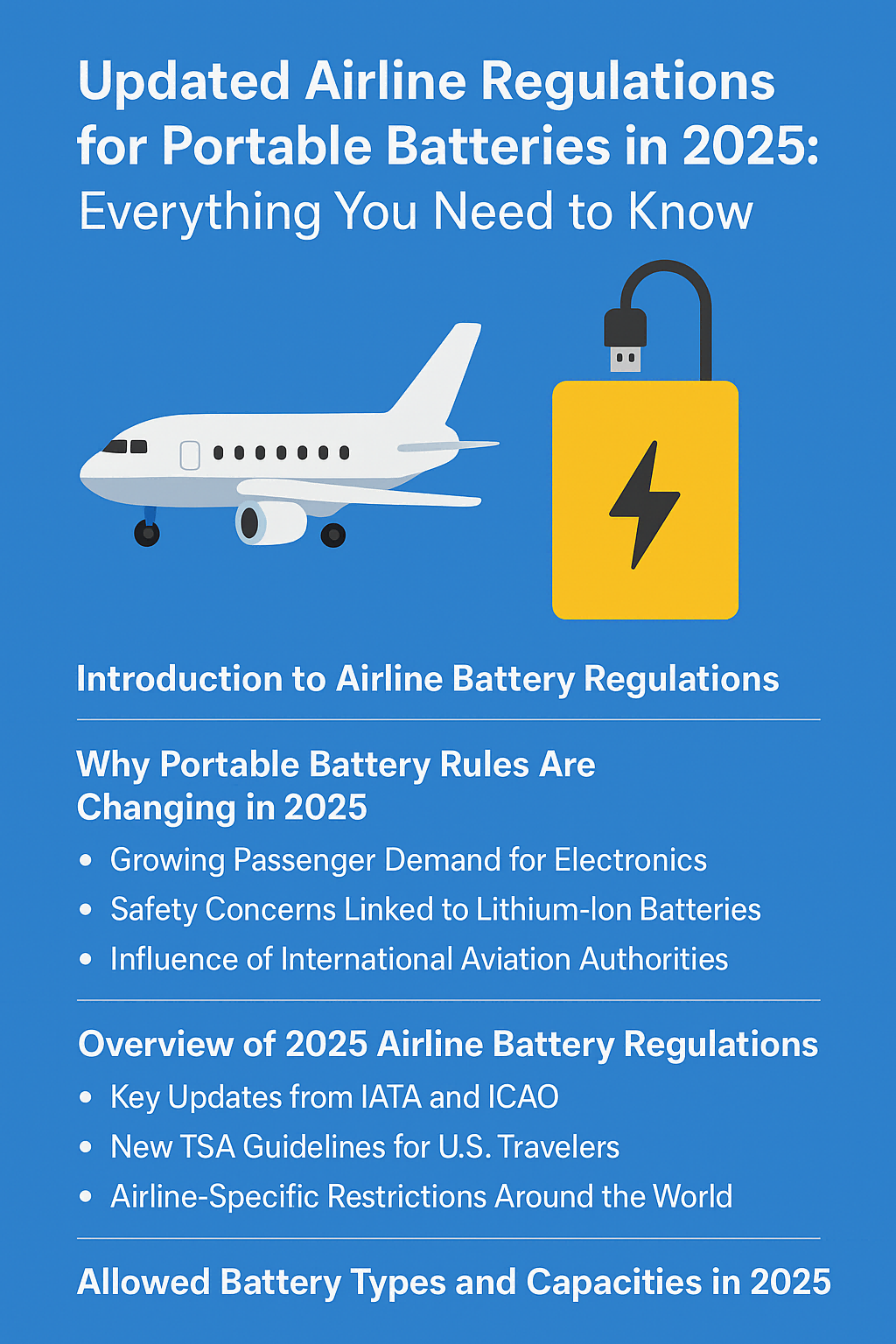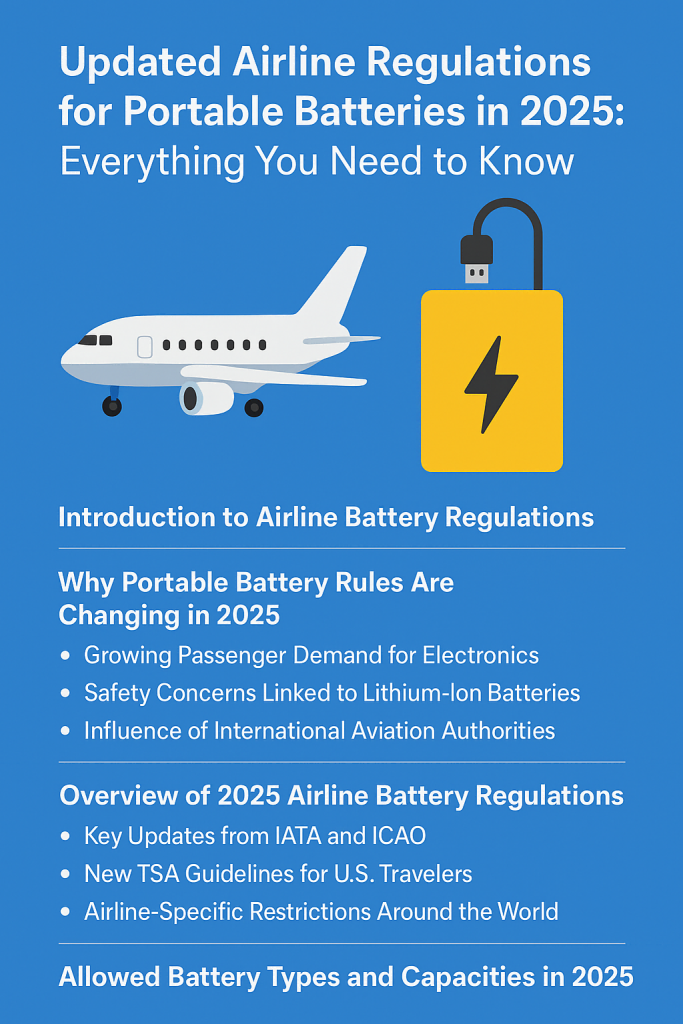Updated Airline Regulations for Portable Batteries in 2025: Everything You Need to Know


Introduction to Airline Battery Regulations
Air travel has become inseparable from technology. Whether it’s laptops, tablets, smartphones, or portable chargers, travelers depend on devices to stay connected during flights. But with convenience comes responsibility, especially when it comes to the safe transport of portable batteries.
Airline regulations have always placed strict controls on lithium-based batteries due to the risk of overheating, short-circuiting, and even fire. In 2025, new global and regional updates are being rolled out to improve passenger safety while adapting to the growing use of high-capacity batteries.
Understanding the updated airline regulations for portable batteries in 2025 is essential for travelers who want to avoid last-minute hassles at the airport. Let’s dive into the reasons behind the changes and what you need to know before boarding your next flight.
Why Portable Battery Rules Are Changing in 2025
Growing Passenger Demand for Electronics
Today’s travelers don’t just carry one device—they bring a whole ecosystem of gadgets. Business travelers rely on multiple laptops, content creators carry cameras and drones, and everyday passengers often have power banks to keep phones alive during long journeys. The increasing reliance on electronics has led to a greater demand for clear, standardized rules.
Safety Concerns Linked to Lithium-Ion Batteries
Lithium-ion batteries, while efficient, have a history of safety incidents. Cases of overheating and thermal runaway have been reported on aircraft, prompting authorities to tighten regulations. In 2025, stricter watt-hour (Wh) limits and carrying procedures aim to minimize risks.
Influence of International Aviation Authorities
Global organizations such as the International Air Transport Association (IATA) and the International Civil Aviation Organization (ICAO) regularly update guidelines that airlines must follow. The 2025 updates align international safety standards while giving flexibility to regional aviation bodies like the TSA in the U.S. and EASA in Europe.
Overview of 2025 Airline Battery Regulations
Key Updates from IATA and ICAO
In 2025, IATA and ICAO introduced updated limits on portable batteries, requiring travelers to declare high-capacity units at check-in. Airlines must now provide clearer guidance to passengers regarding what is allowed.
New TSA Guidelines for U.S. Travelers
The TSA (Transportation Security Administration) has implemented new screening protocols for power banks and spare lithium-ion batteries. Passengers carrying more than two spare batteries above 100 Wh must now request airline approval in advance.
Airline-Specific Restrictions Around the World
Different carriers have their own interpretations of global guidelines. For instance, some Asian airlines have banned power banks exceeding 160 Wh, while European carriers allow them with special authorization. Always check your airline’s website before traveling.
Allowed Battery Types and Capacities in 2025
Lithium-Ion vs. Lithium-Metal Batteries
- Lithium-ion batteries (rechargeable) remain the most common and are permitted under strict watt-hour limits.
- Lithium-metal batteries (non-rechargeable, often found in cameras and medical devices) face tighter restrictions due to fire risks.
Maximum Watt-Hour (Wh) Limits for Carry-On
- Up to 100 Wh: Generally permitted in carry-on luggage without restrictions.
- Between 100–160 Wh: Allowed with airline approval, usually limited to two per passenger.
- Above 160 Wh: Typically prohibited for passenger flights.
Rules for Spare Batteries
Spare batteries are never allowed in checked baggage and must be kept in carry-on bags with terminals covered to prevent short circuits.
Carry-On vs. Checked Luggage Rules
Why Portable Batteries Must Be in Carry-On
Lithium-based batteries can overheat. If stored in the cargo hold, crew cannot access them in case of fire. This is why airlines require passengers to keep them in carry-on bags where flight attendants can respond quickly to emergencies.
Prohibited Items in Checked Bags
Power banks, spare lithium batteries, and e-cigarette batteries are strictly banned in checked luggage in 2025. Attempting to pack them in checked baggage can result in fines or confiscation.
Special Regulations for Power Banks and Charging Devices
Limits on High-Capacity Power Banks
With more passengers carrying power banks to keep their devices charged, airlines have introduced stricter capacity rules. In 2025:
- Power banks up to 100 Wh are generally permitted without approval.
- Power banks between 100–160 Wh require airline authorization, and you may be limited to two units per passenger.
- Any device above 160 Wh is banned on passenger flights and must be shipped as cargo under hazardous goods handling.
Airline Approval for Oversized Batteries
If you travel with professional equipment like video cameras, drones, or medical devices requiring large-capacity batteries, airlines now require pre-flight approval. This often involves submitting documentation about the battery’s specifications and safe handling practices.
Tips for Traveling with Portable Batteries in 2025
Packing Guidelines for Safety
- Store batteries in original packaging or use protective cases.
- Cover battery terminals with insulating tape to prevent short circuits.
- Avoid packing damaged or swollen batteries, as they may be confiscated.
How to Declare Batteries at the Airport
If you’re carrying batteries above 100 Wh, declare them at check-in. TSA officers and airline staff may request inspection before boarding. Having documentation (such as manufacturer labels) can speed up the process.
Best Practices for Frequent Flyers
- Invest in travel-friendly power banks (below 100 Wh).
- Keep batteries easily accessible during security checks.
- Always carry backups in compliance with airline rules to avoid last-minute stress.
Regional Differences in Airline Battery Rules
North America (FAA & TSA)
- FAA and TSA enforce strict carry-on rules.
- Portable batteries up to 100 Wh are allowed, while larger ones require airline approval.
- Multiple spares are allowed, but the number of larger batteries is capped at two.
Europe (EASA Guidelines)
- The European Union Aviation Safety Agency (EASA) aligns with ICAO standards.
- However, some European airlines impose stricter caps on spare batteries to minimize risks.
Asia-Pacific (China, Japan, Singapore)
- Chinese airlines typically enforce stricter controls, requiring airline approval even for mid-range (100–160 Wh) batteries.
- Japan and Singapore align with ICAO but often emphasize proper labeling and packaging.
Middle East & Africa
- Airlines in this region follow IATA’s guidelines but may impose additional screening for oversized batteries due to past incidents involving thermal runaway.
Business and Commercial Implications
Impact on Tech Travelers and Digital Nomads
For remote workers, content creators, and tech professionals, updated regulations can feel restrictive. However, many battery manufacturers are now designing airline-approved power banks under 100 Wh to cater to this growing market.
Airline Adaptations to New Rules
Airlines are also adapting by offering:
- In-seat charging ports on more flights.
- Clearer information about approved devices.
- Partnerships with electronics brands to promote safe travel accessories.
Future of Airline Battery Regulations Beyond 2025
Innovations in Battery Safety
Research into solid-state batteries and fire-resistant casings could lead to fewer restrictions in the future. These technologies promise higher safety and energy efficiency, potentially reshaping aviation rules.
Potential for Relaxed Restrictions
If safer battery technologies become mainstream, we may see a relaxation of current restrictions. Airlines and regulators are already considering pilot programs to test these advancements in real-world travel.
Frequently Asked Questions (FAQs)
1. Can I bring a 200 Wh power bank on a plane in 2025?
No. Any battery over 160 Wh is not allowed on passenger flights. It must be shipped as cargo with hazardous material clearance.
2. Are spare AA or AAA batteries restricted under new rules?
No. Alkaline or nickel-metal hydride (NiMH) batteries like AA or AAA are generally permitted in carry-on and checked luggage. The restrictions mainly apply to lithium-based batteries.
3. Can I put my power bank in checked luggage if it’s under 100 Wh?
No. All spare lithium-ion batteries and power banks must be in carry-on luggage only, regardless of size.
4. What happens if I pack prohibited batteries in checked luggage?
Your bag may be flagged, and prohibited items will likely be removed. In some cases, passengers may face fines or denied boarding.
5. How many spare lithium-ion batteries can I carry in 2025?
Most airlines allow unlimited spare batteries under 100 Wh, but larger ones (100–160 Wh) are limited to two units with airline approval.
6. Are drone batteries allowed on flights in 2025?
Yes, but restrictions apply. Most drone batteries fall within the 100–160 Wh range, which means you’ll need airline approval and must carry them in your hand luggage.
Conclusion: Staying Compliant with Airline Battery Rules in 2025
The updated airline regulations for portable batteries in 2025 aim to strike a balance between passenger convenience and aviation safety. While the rules may feel stricter, they’re designed to prevent dangerous incidents caused by overheating or fire.
Travelers can stay compliant by:
- Carrying batteries only in hand luggage.
- Following watt-hour limits.
- Declaring high-capacity units at check-in.
By preparing ahead, passengers can avoid unnecessary delays and enjoy safer, stress-free air travel.
For official updates, travelers should always check with their airline and consult resources like the International Air Transport Association (IATA).
















